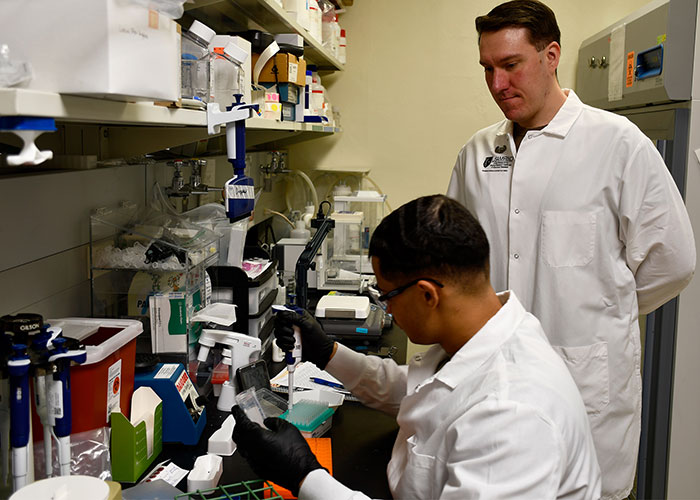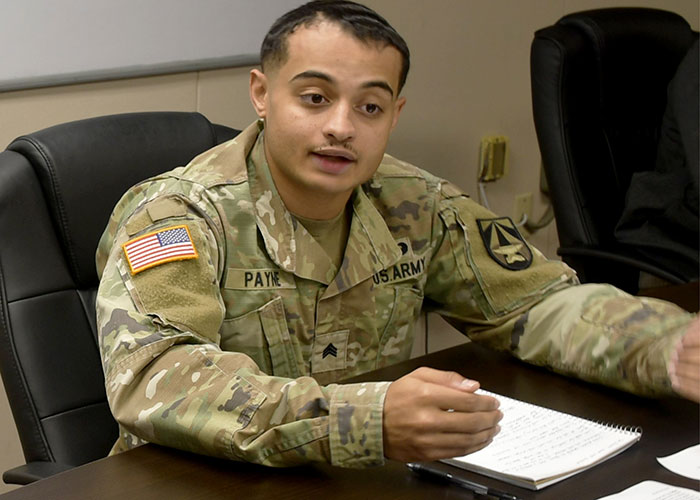USAMRIID Blood Testing Protocol Will Improve Disease Surveillance

The U.S. Army Medical Research and Development Command's Institute of Infectious Diseases is developing a new process for screening blood samples that will enable researchers to assess overseas disease risks more quickly and at less cost, enabling the military to improve operational readiness by better protecting the health of deployed Warfighters.
The new protocol, developed by the Applied Diagnostics Branch of USAMRIID's Diagnostic Systems Division, uses blood spot cards made of a thick cellulose cardstock that absorbs blood from a simple finger stick. Unlike traditional intravenous blood draws, blood spot cards don't require specially trained clinicians, sterile equipment, anti-coagulant drugs or temperature-controlled storage containers for preparation and shipment. That makes them easier and more cost-effective for serologists – scientists who study antibody responses in blood – to use in assessing potential pathogenic risks over large geographic areas, especially in places with limited public health systems.
"The idea of using blood spot cards is not new in serology," explains Capt. Christopher Davis, Ph.D., the branch's chief operations officer. "What is new is the protocol we've established that will let us use blood spot cards to conduct serosurveillance" – the use of blood samples to monitor disease prevalence and previous exposures – "the same way that we currently use blood draws."
Before this new technique could be deployed in the field, however, USAMRIID first needed to demonstrate that antibodies and other protein biomarkers could be extracted from blood spot cards as easily as they could be obtained from traditional blood samples, and that the extraction process would not require a change in the lab's existing workflow or the use of additional instrumentation. The chief of the Applied Diagnostics Branch, Dr. Keersten Ricks, tasked Davis and medical laboratory technician Sgt. Jackie Payne with finding those answers.
Payne developed a testing method that requires only a hole punch, a buffer solution to keep the antibodies stable – skim milk works great – and a sample tube. After subjecting blood spot cards to a battery of tests, including letting them sit for days at room temperature to determine if that affected the sample quality, Payne found that the blood spot cards produced test results that were statistically indistinguishable from whole blood samples.

Payne and Davis are now refining the antibody extraction procedure by nailing down variables such as the minimum amount of blood required to obtain an accurate result and the temperature range for safe storage. Once that work is done, Payne will prepare a standard operating procedure that will allow serologists to use the new protocol in labs around the world.
The new extraction protocol developed by Payne and Davis is an important contribution to USAMRIID's ongoing effort to build serologic testing capacity in partner laboratories throughout AFRICOM, EUCOM and INDOPACOM. Many of Dr. Ricks' collaborators around the world have been collecting samples on blood spot cards in the field for years as part of serosurveillance efforts funded through the Defense Threat Reduction Agency's Biological Threat Reduction Program and the Armed Forces Health Surveillance Division's Global Emerging Infectious Disease Surveillance. The new protocol will enable USAMRIID and its international partners to test those blood spot cards using the same advanced instrumentation used to test whole blood samples, ensuring more comprehensive and accurate assessments that can help prevent the spread of communicable diseases.
"I believe this protocol can improve operations because it increases the number of samples that we can test," says Payne. "Currently, we only get a handful of samples from humans and livestock in a particular location. Does that really give us a true understanding of what's going on in that area? Probably not. Whereas with the blood spot card, the ease of use and accessibility means that anybody can use it and we can get more samples, which gives us a better understanding of what's going on in areas that don't have the medical capabilities that we do here at USAMRIID."














